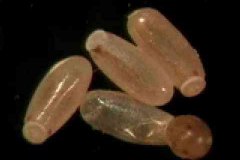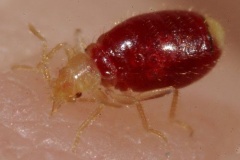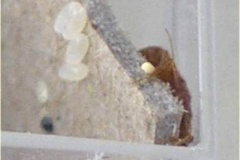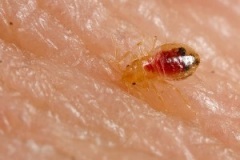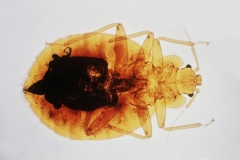Download a bed bugs brochure Tips for preventing bed bug infestation in the work place Tips for preventing bed bug infestation at home
What are bed bugs? Where are bed bugs found? How do I know if a place or item is infested with bed bugs? What do bed bugs do to humans? Do bed bugs spread disease? How do I know if Ive been bitten by bed bugs? How are bed bugs spread? How can I keep from getting bed bugs? I think I may have been exposed to bed bugs in a public place and want to keep them out of my house. What should I do? If bed bugs have infested part of my house, how do I get rid of them? I thought bed bugs werent a problem in the U.S. Why are they of concern? Can the Health Department do anything to make someone get rid of bed bugs? Where can I get more information on bed bugs?
What are bed bugs? Bed bugs are small, flat insects, usually brown or reddish-brown in color. Bed bugs are typically about 1/4 of an inch long. Bed bugs do not fly, but can quickly move across floors, walls and other surfaces. They are typically active at night.Bed bugs are now common in the United States. They can be found in any setting regardless of whether it is clean or dirty.
Where are bed bugs found? Bed bugs are typically found in luggage, clothing, bedding and furniture. They can live in almost any crevice or protected location.
Bed bug infestations are common in places where people come and go frequently, such as hotels, motels, dormitories, shelters, apartment complexes and prisons.
Unlike many other pests, bed bugs are not prevented by clean conditions, and can be found in places that are frequently and thoroughly cleaned.
Locally, bed bugs have been found in hotels, apartment units, single family homes, libraries, workplaces, etc.The potential exists for them to be transported to almost any public building, vehicle or work site.
How do I know if a place or item is infested with bed bugs? Bed bugs typically infest mattresses, box springs, bed frames and couches. These areas usually have dark spots and stains from the dried excrement of the bed bugs.
Another sign of bed bugs is rusty or red spots of blood on bed sheets, mattresses or walls.
Heavy bedbug infestations may also have a musty smell.
What do bed bugs do to humans? Bed bugs require blood to survive. To get this nourishment, they often feed on humans. Bed bugs usually bite people at night when they are sleeping, and feed on any area of exposed skin, such as the face, neck, shoulders, arms or hands. The amount of blood lost by humans to bed bugs is minimal.
The bites do not hurt, so the person usually does not know that he/she has been bitten, but bed bug bites do irritate the skin. People with bed bug bites may develop a small, hard, swollen white welt at the site of the bite. The welts are accompanied by severe itching that usually lasts a couple of days. Anxiety and restlessness are also common in people who have bedbug bites.
Do bed bugs spread disease? Bed bugs do not appear to transmit diseases. The greatest threat from the bites in humans is the swelling and inflammation at the site of the bites, which can lead to secondary bacterial skin infections.
The bites can be treated with antihistamines or over-the-counter cortisone creams. Check with your health care provider to determine which treatments you should use.
How do I know if Ive been bitten by bed bugs? Not all bites or bite-like scratches are due to bed bugs. If you wake up with itchy bites that you did not have when you went to sleep, then you may have bed bugs. To confirm if the bugs are present, a professional will most likely have to identify them.
Symptoms of bed bug bites are:
Bites that appear overnight, usually small, hard, swollen white welts accompanied by severe itching which can last several days. The degree of reaction to the bites can vary among individuals
How are bed bugs spread? Bed bugs can be found in mattresses, box springs, bed frames and couches, as well as luggage, clothing and backpacks, where they hide in the seams. They do not fly but will crawl quickly across the floor, wall or other surface. They are spread when an infested item is moved from place to place. Bed bug bites are not contagious.
How can I keep from getting bed bugs?
I think I may have been exposed to bed bugs in a public place and want to keep them out of my house. What should I do? Take any clothing or items that you think have bed bugs off before entering your house. Put them in a plastic bag and then immediately wash the items in the washing machine and run them through the dryer on the hot cycle--at least 120 degrees or higher.
This will kill bedbug eggs and the bugs themselves.If needed, you canfirst place items directly into the dryer to kill the bugs--especially for items suchas backpacks and duffel bags and such.
While the weather is hot outside, you could also place suspected items in a black plastic bag, seal it shut, then allow to sit in direct sunlight for a day or two.If done during hot sunny weather, the temperature in the bag should reach 120 or higher.
If bed bugs have infested part of my house, how do I get rid of them? Once bed bugs have infested an area, treatment by a professional exterminator is necessary. The exterminator may use a combination of insecticides to kill off the bed bugs. The insecticides are applied to all areas where the bed bugs are discovered, or where they tend to crawl or hide. In many cases, multiple applications are necessary to completely rid the infested area of bed bugs. In apartments and hotels, nearby units may need to be treated as well. Furniture and related items, as well as heavily infested bedding or clothing, may need to be thrown out.
I thought bed bugs werent a problem in the U.S. Why are they of concern? Bed bug infestation was common in the U.S. prior to World War II, but the use of DDT (a chemical insecticide) in the 1940s and 1950s caused bed bugs to all but vanish from the U.S. Because of safety concerns, DDT is no longer used for pest control, and many people use baits to control ants and cockroachesthese baits are not effective on bed bugs. An increase of international travel, particularly to areas of the world where bedbugs have remained prevalent has also lead to an increased prevalence of bed bugs in the U.S. However, bed bugs are still rare when compared to other household pests.
Can the Health Department do anything to make someone get rid of bed bugs? The Health Department does not have the authority to require bed bugs to be removed from private residences, such as homes and apartments. In public buildings, the Health Department only has the authority to act if the facility is inspected for another reason--for example, a hotel room or a restaurant.
Where can I get more information on bed bugs?For more information online, visit: University of Kentuckys Department of EntomologyOhio State University Extension Office
Or you can call the Health Departments Environmental Health and Safety office at 859.341.4151.
Source: Northern Kentucky Health Department, University of Kentucky
Excerpt from:
Northern Kentucky Health Department | Bed Bug Fact Sheet

 Residence
Residence  Location
Location 

